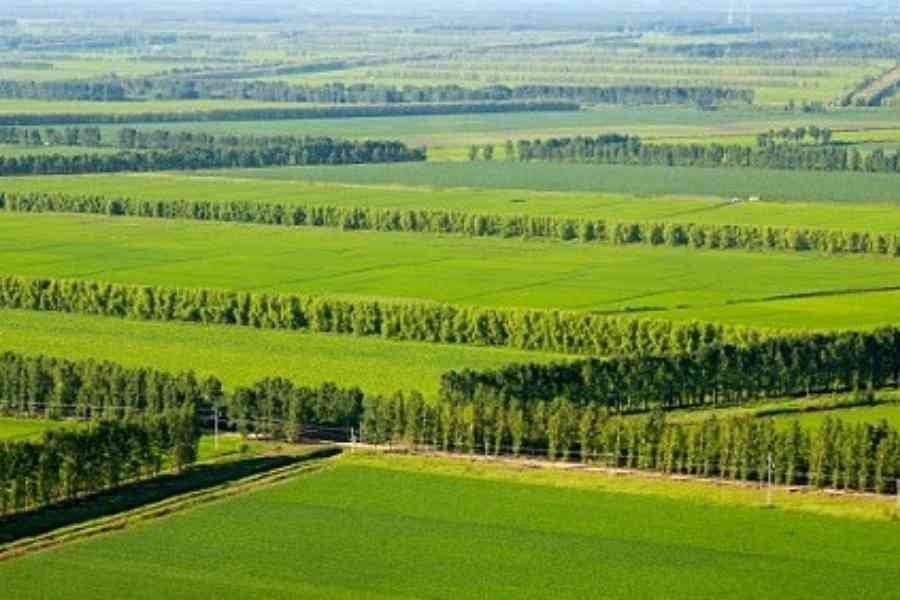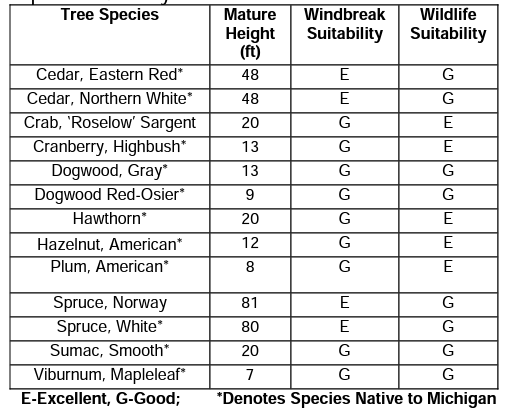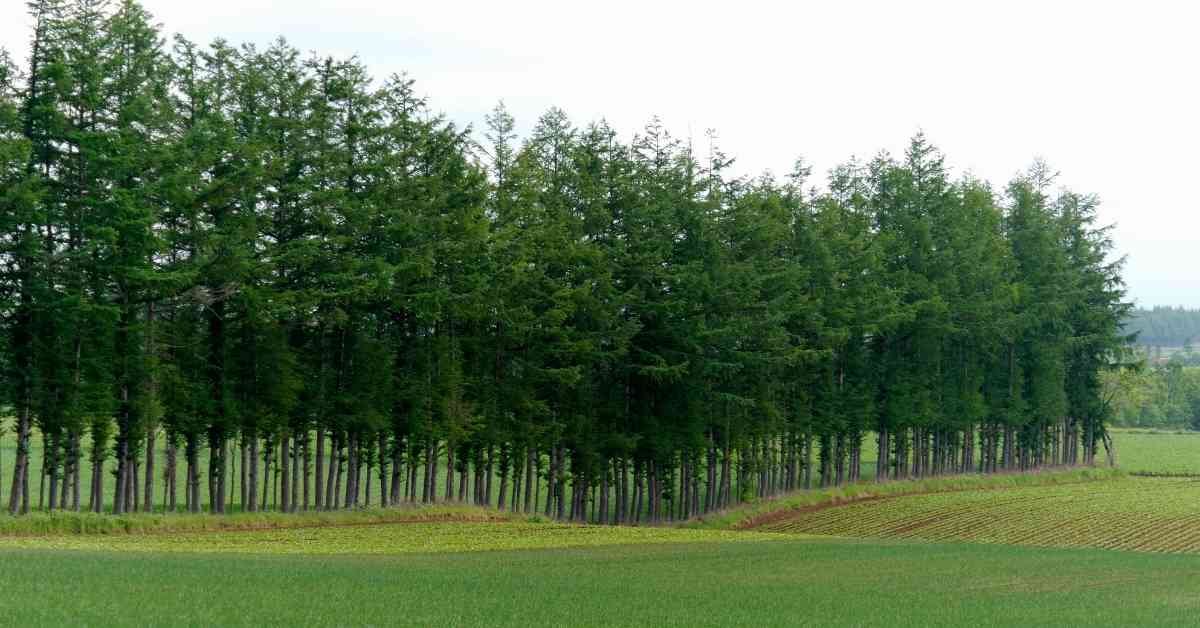Shelterbelts are a type of agroforestry that is used to provide protection for crops and livestock from the wind. They can also be used to improve the health of the soil, stop soil erosion, and help water get back into the ground. There are different types of shelterbelts, and each has its own benefits and purposes. In this blog post, we’ll take a closer look at what shelterbelts are, their design and benefits, and the purpose they serve in agriculture. Stay tuned!
What is Shelterbelts?
A windbreak or shelterbelts is a plantation usually made up of one or more rows of trees or shrubs planted in such a manner as to provide shelter from the wind and protect soil from erosion. They are commonly grown in hedgerows around the edges of fields on farms.
Or, Shelterbelts/Windbreak is a wide range of trees, shrubs, and grasses planted in rows that go right across the land at right angles to the direction of the prevailing defect in the movement to reduce wind. Or velocity and general protection to cultivated area wind erosion and decreasing effect of hot winds.

What is the purpose of shelterbelts?
- To deflect air currents.
- To reduce the velocity of winds.
- To provide general protection to the downwind areas against the effects of wind erosion.
- To protect the leeward areas from desiccating effects of hot wind.
- To provide fuel, fodder timber, etc.
- To protect field crops/livestock from cold/hot wind.
- To prevent soil erosion.
- To reduce evaporation from farmlands.
- To improve the microclimate.
- Fencing and boundary demarcation.
Shelterbelts installation
Step-by-step guide of shelterbelts installation are as follows:
- Prepare a firm seedbed free of weeds for the trees and plants
- Prepare the site in the fall for planting the trees in the spring
- Cultivate the land and prepare the soil for planting the trees
- Choose a specific herbicide recommended by the local extension office
- Apply the herbicide according to the label
- Plant the bare-rooted stock and cuttings
- The ideal time for planting is before June 1 or after October 1 until
- Ensure adequate soil moisture and good weather
- Control weeds within at least a 3-foot radius around each tree for optimum growth
- Use fabric weed barriers to minimize weed growth
- Don’t mow around the trees to control weeds
- Apply adequate water to the trees
- Take care of the 3-foot radius zone around each tree

Shelterbelts design/characteristics
- Shape and Composition
- Density and Width
- Orientation
- Length
Shape and Composition
A typical shelterbelt has a triangular cross-section. It can be done by planting tall trees in the center, flanked on both sides, successfully on other trees, tall shrubs, and low spreading shrubs and grasses. Then there should be a systematic mixture of trees, shrubs, and grasses, keeping their height, shape, crown form, longevity, resistance to insects, and usefulness in view.
Density of Width
A certain amount of penetrability is desirable in shelterbelts. It has been found from experience that solid walls provide considerable protection immediately behind them on the leeward side, and the effect disappears after a short distance. In addition, there is a significant fluctuation in velocity on the leeward side.
But it is a partially penetrable shelterbelt, the zone of influence is much greater, and the velocity curve shows a smooth, slowly declining trend. Thus partially penetrable shelterbelt is more effective. This penetrable is done by planting trees and shrubs adequate in their rows.
The planting of shrubs should be done 1 to 1.5 m apart and trees 25 m apart in rows. The width of the shelterbelt depends upon climatic conditions, wind velocity, and soil type.
The central arid zone research institute, Jodhpur, has advised data in the arid zone, and wind velocity does not exceed 20 km/ hr. Therefore, a typical belt may consist of 35 rows; in the same cases, seven rows may be planted at a distance of 4 m.
Orientation
The orientation of the shelterbelt depends upon the wind direction and velocity, particularly during the vulnerable season, and the shelterbelt should be should oriented as early as possible at right angles to the prevailing wind or the wind to the winds that are more damaging to the prevailing time of the year. If winds blow from different directions, a shelterbelt should be raised in quarters.
Height and Spacing
The height of the shelterbelt is more critical because it affects the distance to which protection will be given on the leeward side. The higher the trees forming the shelterbelt, the greater the beneficial effect on the leeward side. A shelterbelt protects the area up to 15 to 20 times the height of the belt.

Best trees for windbreak
The choice of species to be raised in the shelterbelt depends on the area’s climate, soil, and topography. It is better to grow local species that may serve the object in view, as they can be quickly established. The selected species should be fast-growing, drought-resistant, and unpalatable to the animal. It should not be leaflets at a time when protection is required. The following fast-growing and tall trees/species are recommended for shelterbelt/windbreak.
- Shrubs: Calotropica, procers, crotolonia, brubia, calligoman, polygonides, clearadendron pheromones, cassia curriculum, dedonae visosa, jatropha curcas, sysabenia aculeate.
- Small trees: Acacia jacyumental, Acacia lecucophillea, Saydora oleodes.
- Shelterbelt trees: Acacia Arabica, A. senggal, Albrizza labback, A. ordirchata, Dalbergia sisso. Lannnea coronmendoice, Prospopis julifora, Progemia pinnata, Eucalyptus spp.

Benefits of windbreak trees
- Moderating effect on temperature. It can increase or decrease the temperature.
- It can increase the humidity from 1 to 50% because of faster evaporation from soil and crops retained due to reduced air movement.
- It retards evaporation.
- It increases soil moisture.
- It reduces the wind velocity and wind erosion of soil from the orchard.
- It increases fruit production by minimizing wind damage.
- Field windbreaks protect windsensitive crops, control wind erosion, and increase bee pollination and pesticide effectiveness.
- Livestock windbreaks help reduce animal stress and mortality, reduce feed consumption, and help reduce visual impacts and odors.
- Living snow fences keep roads clean of drifting snow and increase driving safety.
- They can also spread snow evenly across a field, increasing spring soil moisture.
- It stores carbon.
- Crop yield and economic potential are increased.
- A wildlife habit is created for birds and insects.
- Windbreaks improve the local environment.
